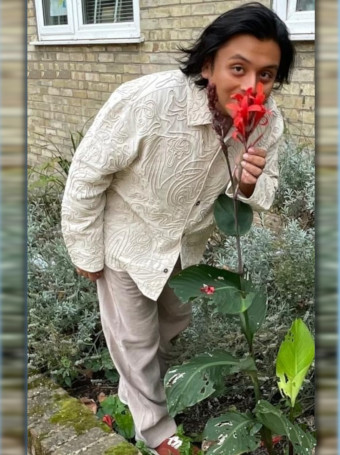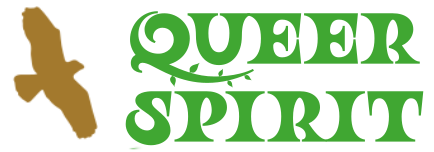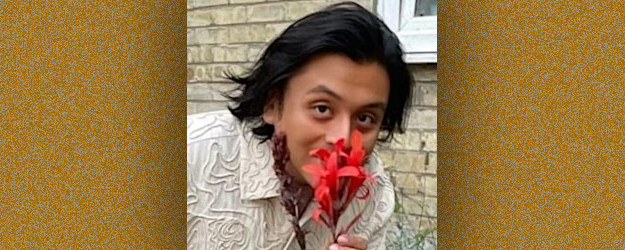Queerness is the crossweave on the loom of human life
![]()
Queerness is the crossweave on the loom of human life.
Women who love Women
Men who love Men
Trans and Non-Binary People...
have always been part of the human tapestry.
In many cultures of the world queerness was not only accepted as natural,
it was seen as having spiritual qualities.
At Queer Spirit Festival we affirm and celebrate the naturalness
of queer gender identities and sexualities,
and the spiritual gifts that go with them!
BORN of EARTH – BORN to LOVE!
Queer Consciousness is Rising
The Deviants are Finding Their Divinity.
QUEER SPIRIT FESTIVAL RETURNS
August 15-19, 2024, Bridwell Park, Devon
A 5-day celebration of the creative spirit, natural magic and healing gifts of LGBTQ+ people.
![]()
The LGBTQ+ community is involved in a gradual process of decolonisation from ideas around gender expression and sexuality that were developed by late 19th century European psychologists and sociologists, at a time when centuries of religious and legal persecution of queer people still heavily dominated people's views. On top of the labels of sin and crime, to be gay or gender-variant became labelled a sickness, a mental illness, and remained a crime in the UK for decades to come.
In most parts of the world this was, historically, not the case at all. In some places, such as China and Japan, queerness was simply accepted as part of the divine creation, in some it was even revered as bringing holy gifts. As we learn about and celebrate this part of our queer history, we are delighted to welcome Rafael Montero, a healer from South America working to revive knowledge of the tradition of non-binary Pampayruna shamans in the indigenous culture – see more below - to Queer Spirit Festival this summer. He/They will be bringing a Pachamama Earth-honouring ritual to Bridwell Park.
In Japan, homosexuality was largely seen as 'what the monks did' – since they were forbidden from sexual relations with women, it was accepted as natural that they would be intimate with each other. Jesuit leader Francis Xavier, in the mid 16th century complained that the Buddhist bonzes of Japan: “.. are inclined to sins, abhorred by nature. They even confess it and don’t deny it. It is visible and public to all, including men and women, young and old, none of whom think much of it nor despise it as it seems to be a common habit indeed.”
In his book The Origin and Development of Moral Ideas, Finnish philosopher Edward Westermarck (1862-1939), published 1906, wrote that: “In Japan, pederasty is said by some to have prevailed since ancient times, whereas others are of the opinion that it was introduced by Buddhism about the sixth century of our era. The monks used to live with handsome youths, to whom they were often passionately devoted; and in feudal times nearly every knight had as his favourite a young man with whom he entertained relations of the most intimate kind, and on behalf of whom he was always ready to fight a duel when occasion occurred. Tea-houses with male geishas were found in Japan till the middle of the nineteenth century…”
In the Americas, the native tribal peoples recognised more than two genders, and gave specialist roles in the community to those who were seen to be both male and female in one body. The shocked European explorers called these shamans 'berdache', a Persian term for a gay bottom, a sex slave – and the term stuck until the 1990s when the queer Native American healers came together and chose a new name for themselves, one that gave a nod to the many terms that the tribes used to use – they chose Two Spirit. Native terms included wíŋkte (Lakota, translates as ‘wants to be like a woman’), nádleehé (Navajo, translates as ‘one who changes’), mixu’ga (Omaha, translates as ‘instructed by the moon’). In the USA 2S is now often added to our LGBTQ+ alphabet, and stands as a recognition of the spiritual associations that queerness points to.
Judy Grahn, lesbian poet and author, wrote in Another Mother Tongue (1984):
“The tribal attitude said, and continues to say, that Gay people are especially empowered because we are able to identify with both sexes and can see into more than one world at once, having the capacity to see from more than one point of view at a time.”
Malidoma Some, wisdom teacher of the Dagara Tribe from West Africa, shared his tribal view of homosexuality in the 1990s:
“Why is it that, everywhere else in the world, gay people are a blessing, and in the modern world they are a curse? It is self-evident. The modern world was built by Christianity. They have taken the gods out of the earth sent them to heaven, wherever that is. And everyone who aspires to the gods must then negotiate with Christianity, so that the real priests and priestesses are out of a job.”
Sobonfu Some, Malidoma's wife, who like him came to the west to share African teachings, wrote in her book Spirit of Intimacy (2000):
“The words gay and lesbian do not exist in the village, but there is the word gatekeeper. Gatekeepers are people who live a life at the edge between the worlds – the world of the village and the world of spirit...
“Gays and lesbians in the West are often very spiritual, but they have been taken away from their connection with spirit. My feeling is that without that outlet or that role in the culture, they have to find other ways of defining themselves. This could be one of the reasons why they would want to get married or make themselves look as though they do not have a unique purpose...
“The life of gay people in the West is in many ways a reaction to pressure from a society that rejects them. This is partly because a culture that has forgotten so much about itself will displace certain groups of people, such as the gay community, from their true roles.”
I feel very fortunate to have met Sobonfu Some at an event in London in 2016. I asked her a question about the Dagara tribal attitude to gay people – she burst into a huge joyful laugh, saying: “We don’t call them gay... they are the special ones, they are the gatekeepers, without them nothing can happen.” The open mouthed shock on the faces of the white middle class audience was a treat.

We are very pleased to welcome Rafael Montero to Queer Spirit Festival this summer. He/They identifies as a Pampayruna – a non-binary healer from the Kallaway people of the Andes mountains in South America. Rafael will be offering a Sacred Healing Sounds workshop, a Pachamama Earth-Honouring Ritual and personal consultations.
Interviewed in a recent edition of Sacred Hoop magazine, Rafael spoke about queer people in the pre-Christian era:
“We know that homosexuality was very normal in the pre-Columbian times. For instance, in Moche and Chimú cultures, which are very early cultures, dating from about 300 BCE to 700 CE, from the north of Peru. They have erotic ceramics, which depict homosexuals having sex, but the sex had the quality of something sacred... 40% of Moche ceramics depict homosexual relations, and they are also seen in Chimú ceramics. And Aymara culture - which is closer to me - regarded homosexual people as supernatural beings, capable of magic. In the Inca empire, homosexuality and cross-dressing were seen as acts of worship, commonly practised in religious rituals and temples.
“There are those two big groups of non-binary or ‘queer’ priests, the Pampayruna and the Quariwarmi. The Quariwarmi were cross dressed priests, who performed rituals in honour of Chuqui Chinchay a jaguar dual-gendered god. This is written in the chronicles of the Spaniards, which also recorded that when the Inca king had a baby, he would invite these non-binary priests to protect the baby. Chuqui Chinchay was a jaguar protector of the queer priests.
“We were priests, because we are the ones who are a man and a woman living in one body, so we had the two polarities, shown with the cross dressing. The Quariwarmi have a wonderful union of two natures, and we know they were respected, because the Inca king invited them to give protection to his baby.
“Lesbian relationships were also highly regarded by the Inca. Lesbians were known as Holjoshta, and they enjoyed many privileges - they could even participate in combat - and were very, very loved by the Inca king, because they were very strong... I recall one of the Amazonians - which is what the Spaniards called them - was said to be able to kill six conquistadors; so they were really very good warriors.
“The supreme god Wiracocha – probably intersexual - was served by priests and servants of this third gender. For us, homosexuality was sacred, and was normally practiced. But when the Spaniards came, they found it difficult to understand, so they called us prostitutes, because of their Eurocentric and Christian mentality. Cieza de León, who wrote a chronicle in 1550, recorded that homosexuality was an act found in cults, and there were gay men who lived in temples who were effeminate, and had sacred sex with the upper classes of Inca society, because he sexual union was the manifestation of the sacred. These priests were the Pampayruna, which is the name I choose to call myself. How this sexual religious service was practiced we cannot know, but we know that the Pampayruna were very feminine.”
Now that we can access the histories and learn from the cultures of the whole Earth, we see that the European obsession with the suppression of sexual, especially homosexual, activities was an aberration – was in fact part of the suppression of ancient, pagan, Goddess honouring cultures that celebrated sexuality. In those pagan times, just as in the rest of the world, queer people would naturally take spiritual roles, examples include as the Gallae priests of Cybele, the assinnu, galatur and kurgurra of Inanna/Ishtar, the megabyzoi of Artemis.
-
Cybele's homeland was Anatolia, in modern Turkey. Her worship was so ancient she was considered to be the Mother of the Greek Gods. Like other Earth Mother deities she was served by effeminate/gay male as well as female priestesses. The Qedesha of Canaan are an example, these queer priests of Asherah, Goddess of the early Hebrew tribes are mentioned in the Old Testament, with Qedesha translated as 'sodomites' in the King James Bible, 'ritual shrine prostitutes' usually in modern versions – in a 14th century English translation Qedesha was translated as 'womanish-men'. The Goddess priests ran the temples, sang laments, performed divinations, held frenzied rituals in Her presence, and brought that presence to worshippers through sexual acts. The Romans adopted Cybele as the Great Mother Goddess of the Empire, and worshipped her for over 500 years until Christianity became the only permitted religion in the late 4th century. Cybele's loud, queer, colourful, Gallae priests spread her worship throughout the Empire – one of them is buried close to Hadrian's Wall.
-
Talking of Hadrian, Emperor of Rome from 117 to 138 CE – he is famous not only for his long wall in Britain, but also for his passionate love for Antinous, his younger male lover. Pederasty (love between older and adolescent males) was an institution of the ancient world, it was a cornerstone of the Greek civilisation. Hadrian and Antinous walked this path, and their love story is one of the greatest romances of the ancient world. Antinous died in mysterious circumstances while the royal party was travelling along the Nile, and at Hadrian's request was deified by the Egyptian priests. The Antinous cult spread quickly through the empire and lasted for over two centuries, reviving the same sex rites of pagan antiquity and was, like the sex-positive worship of the Goddess, a major competitor to the ambitious new religion, Christianity
From which ever part of the world our ancestry birthed us there are associations between queerness and the sacred to be uncovered, there is a holistic pre-colonial, pre-Christian, pre-industrial, worldview to be reclaimed – one that included the Earth, Nature and the Cosmos, and included all people. That called no-one 'unnatural'.
A method we can employ to help decolonise our notions of sexuality and gender is to address the labels we use for ourselves. Just as the Native American Two Spirits are changing the definition of themselves by changing the label, the Radical Faeries have been doing the same work on the edges of the queer universe since 1979, exploring the magic and discovering the healing that comes from connection to nature and to the circle of life, on behalf of the whole LGBTQ+ diaspora, popping up in nature spots around the world and also building permanent sanctuaries for queer healing and self-discovery. Many Radical Faeries, from the UK and elsewhere, are contributing their magic, skills and love to help manifest Queer Spirit Festival. Come meet them!
Mitch Walker in 1997 described Radical Faeries as “the first indigenous spiritual tradition created and sustained by the gay male community in modern times. By 'indigenous' I mean gay-centered and gay-engendered, in contrast to the various gay synagogues, churches, covens etc. In the latter groups, gayness is incidental or additional to the tradition espoused, while in the former it is central and causal. Radical Faeries celebrate and explore the Gay Spirit, which is itself the source of spiritual existence, wisdom and initiation. Because of its indigenous, gay-centered nature, the Radical Faerie movement pioneers a new seriousness about gayness, its depth and potential, thereby heralding a new stage in the meaning of Gay Liberation.”
At Queer Spirit Festival, Radical Faeries are one of many roots feeding into the cauldron of queer cosmic creativity! We are proud to bring together hundreds of people from all parts of our magnificent rainbow community to affirm and celebrate queer gender identities and sexualities, and the spiritual gifts that go with them!







